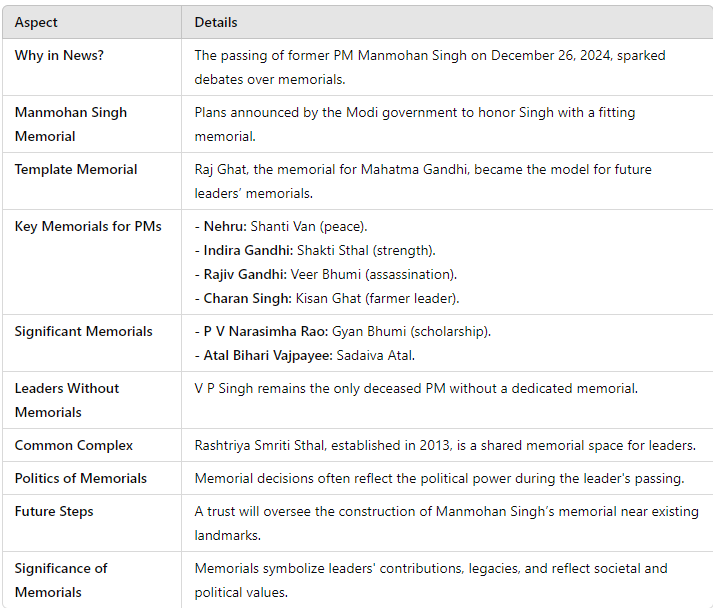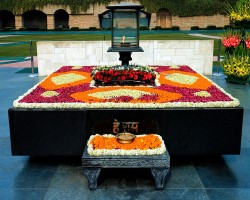Banking Current Affairs
| History |
|---|
|
|
|
Why in News?
The debate over memorials for former leaders reignited following the passing of former Prime Minister Manmohan Singh on December 26, 2024. His cremation at Nigambodh Ghat, rather than a designated memorial, sparked political and public discussions. The Narendra Modi government announced plans to build a memorial to honor Singh, the architect of India’s economic liberalization. Historical Context: Key Highlights on Memorials in India Raj Ghat as the Template: The memorial for Mahatma Gandhi (Raj Ghat) became the model for future leaders' memorials. Located in Delhi near the Yamuna River, it includes a black marble slab marking Gandhi’s cremation site in 1948. Memorials for Prime Ministers: Jawaharlal Nehru: Memorial named Shanti Van in 1964, symbolizing peace. Lal Bahadur Shastri: Memorial named Vijay Ghat in 1966, signifying victory over Pakistan. Indira Gandhi: Memorial named Shakti Sthal in 1984, emphasizing strength. Rajiv Gandhi: Memorial named Veer Bhumi in 1991, symbolizing his assassination. Charan Singh: Memorial named Kisan Ghat in 1987, highlighting his status as a farmer leader. P V Narasimha Rao: Memorial named Gyan Bhumi in 2015, representing his scholarly contributions. Recent Developments: The Rashtriya Smriti Sthal was established in 2015 as a common memorial complex for departed leaders due to limited space in Delhi. This site now houses memorials for leaders like Chandra Shekhar, I K Gujral, and Atal Bihari Vajpayee (Sadaiva Atal). Leaders Without Memorials: Former PM V P Singh (1989-1990), known for implementing the Mandal Commission, remains the only deceased PM without a memorial. Politics Behind Memorials: The location and construction of memorials often reflect the political power at the time of a leader's passing. For instance: Morarji Desai: Memorial built in Gujarat during Congress rule. Narendra Modi Government: Established memorials for P V Narasimha Rao and others, revisiting decisions of previous administrations. Significance of Memorials: Memorials symbolize the legacies of leaders and their contributions. For example: Raj Ghat: Reflects Gandhi’s role in shaping the nation. Shanti Van: Highlights Nehru’s peace-driven leadership. Kisan Ghat: Represents Charan Singh’s advocacy for farmers. Future Plans: A trust will oversee the construction of Manmohan Singh's memorial, possibly near the Sanjay Gandhi Memorial or Shanti Van. The government aims to honor Singh’s economic reforms and leadership with a fitting tribute. Conclusion: The politics, geography, and history of memorials in India underline their role as markers of political legacy and power dynamics. Memorials serve as sites of remembrance and honor for leaders' contributions to the nation's history. 
|
|
|
|
Frequently Asked Questions (FAQs) in Competitive Exams:
1. Which memorial served as the template for other leaders' memorials in India? A. Vijay Ghat B. Raj Ghat C. Shakti Sthal D. Veer Bhumi Answer: B 2. What is the significance of the Kisan Ghat memorial? A. Tribute to Lal Bahadur Shastri’s 1965 victory over Pakistan. B. Representation of Mahatma Gandhi’s role in Indian independence. C. Recognition of Charan Singh’s contributions as a farmer leader. D. Celebration of Indira Gandhi’s strong leadership. Answer: C 3. Which of the following Prime Ministers does not have a memorial in India? A. V P Singh B. P V Narasimha Rao C. Morarji Desai D. I K Gujral Answer: A 4. The memorial Gyan Bhumi is dedicated to which Indian Prime Minister? A. Jawaharlal Nehru B. P V Narasimha Rao C. Lal Bahadur Shastri D. Rajiv Gandhi Answer: B 5. What decision did the Manmohan Singh government take in 2013 regarding memorials? A. Separate memorials for future leaders. B. Establishing a common memorial complex for departed leaders. C. Constructing memorials only outside Delhi. D. Prohibiting the construction of any new memorials. Answer: B 6. Which of the following Prime Ministers' memorials is named Shakti Sthal? A. Indira Gandhi B. Rajiv Gandhi C. Lal Bahadur Shastri D. Atal Bihari Vajpayee Answer: A 7. What is the Rashtriya Smriti Sthal? A. A memorial dedicated to Mahatma Gandhi. B. A memorial for all former Presidents. C. A common complex for departed leaders. D. A space for Prime Ministers only. Answer: C 8. Which Prime Minister's memorial was renamed as Jannayak Sthal by the Modi government in 2015? A. Atal Bihari Vajpayee B. Chandra Shekhar C. V P Singh D. I K Gujral Answer: B 9. What does the Veer Bhumi memorial symbolize? A. The assassination of Rajiv Gandhi. B. Gandhi’s role in forging the Indian nation. C. Nehru’s peace-driven leadership. D. Lal Bahadur Shastri’s military success. Answer: A 10. Why was the Rashtriya Smriti Sthal concept proposed? A. To save land in Delhi from being taken up by individual memorials. B. To consolidate all existing memorials into one location. C. To honor all freedom fighters collectively. D. To allow for future memorials to be built outside Delhi. Answer: A |
| >> More Banking Current Affairs |
